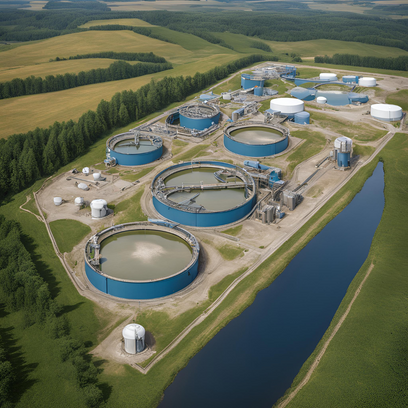Sewage Treatment Plant
Introduction
Our Sewage Treatment Plant (STP) is designed to effectively treat domestic and industrial sewage water, ensuring that wastewater is treated to safe, environmentally compliant levels before discharge or reuse. This system plays a crucial role in maintaining sanitation, improving public health, and protecting the environment by removing contaminants from sewage water, including organic matter, pathogens, chemicals, and nutrients. The STP is widely used in residential complexes, commercial buildings, industrial plants, and municipal areas to address water pollution issues.
Key Features
-
Multi-Stage Treatment Process: Our Sewage Treatment Plant uses a series of treatment processes such as primary, secondary, and tertiary treatment to remove solids, organic matter, and harmful pathogens from the sewage.
-
Compact and Modular Design: Designed to fit within limited spaces, our STP is available in modular designs that can be expanded as per demand, making it ideal for both small and large-scale applications.
-
Energy-Efficient: The system is designed for minimal power consumption while maintaining high treatment efficiency, reducing operational costs and environmental impact.
-
Automatic Control and Monitoring: Equipped with advanced control systems, the STP continuously monitors parameters like flow rate, pH, turbidity, and BOD/COD levels, ensuring optimal performance.
-
Sludge Management: Includes an efficient sludge management system that handles the disposal or treatment of sludge produced during the treatment process.
-
Flexible Discharge Options: Treated water can be reused for various non-potable applications like irrigation, cooling systems, and landscaping, or safely discharged into water bodies as per regulatory standards.
-
Durable Construction: Built with high-quality materials like stainless steel, FRP, and concrete, the system is corrosion-resistant and designed for long-term performance in various environmental conditions.
Benefits
-
Improved Water Quality: Effectively reduces pollutants, making water suitable for reuse or safe discharge into the environment, reducing water pollution and protecting local ecosystems.
-
Environmentally Friendly: Helps reduce pollution in rivers, lakes, and groundwater by treating wastewater to comply with environmental discharge standards.
-
Cost-Effective: Reduces reliance on fresh water for non-potable uses like irrigation and industrial processes, leading to significant savings in water bills.
-
Health Protection: Removes harmful bacteria, viruses, and pathogens, preventing waterborne diseases and ensuring cleaner, healthier environments for communities.
-
Resource Recovery: Enables the recovery of useful by-products like biogas (in anaerobic systems) and treated water for reuse, supporting sustainability and resource conservation.
Applications
-
Residential Complexes: Used to treat domestic sewage in apartments, housing complexes, and gated communities to ensure clean water for reuse or safe discharge.
-
Commercial and Industrial Buildings: Essential for treating wastewater generated in office buildings, hotels, hospitals, and manufacturing facilities, enabling compliance with wastewater regulations.
-
Municipal Sewage Treatment: Helps in treating large volumes of sewage from towns and cities, ensuring proper sanitation and reducing the load on natural water sources.
-
Industrial Plants: Provides an efficient solution for treating industrial effluent, especially in sectors like textiles, pharmaceuticals, food and beverage, and chemicals, where wastewater is highly contaminated.
-
Agriculture: Treated wastewater can be safely used for irrigation, supporting water conservation in agricultural areas.
Working Principle
-
Pre-Treatment (Screening and Grit Removal): Sewage water first passes through a screening process to remove large debris, like plastics and rags, followed by grit removal to eliminate sand, stones, and other coarse particles.
-
Primary Treatment (Sedimentation): In the primary treatment tank, suspended solids settle to the bottom of the tank while lighter materials (such as oils and grease) float to the surface. These materials are then removed, leaving behind partially treated wastewater.
-
Secondary Treatment (Biological Treatment): In this stage, biological processes are used to break down organic matter. The water flows through a biological treatment unit, typically an aeration tank, where bacteria and microorganisms consume organic pollutants. The effluent from the aeration tank is then clarified in a secondary clarifier, where biological solids settle and are removed.
-
Tertiary Treatment (Polishing): The final stage of treatment involves the removal of any remaining pollutants, pathogens, and suspended solids. Tertiary processes may include additional filtration, UV disinfection, or chemical dosing to ensure that the treated water meets the required quality standards.
-
Sludge Treatment: The sludge generated in the primary and secondary treatment stages is treated through processes like sludge thickening, digestion, and dewatering. The treated sludge can be safely disposed of or used as a biofertilizer.
-
Discharge/Reuse: After treatment, the cleaned water can be reused for non-potable applications like irrigation, cooling, or landscaping, or safely discharged into rivers, lakes, or municipal drainage systems as per regulatory norms.
Maintenance Guide
-
Regular Inspection: Conduct routine checks on the mechanical and electrical components, including pumps, valves, and aerators, to ensure they are working properly.
-
Sludge Removal and Disposal: Periodically remove the accumulated sludge from the primary and secondary treatment tanks, as well as the sludge digestion units, and ensure its proper disposal or treatment.
-
Cleaning of Filters and Screens: Clean pre-treatment screens, filters, and aeration tanks to ensure optimal flow and avoid blockages.
-
Water Quality Monitoring: Regularly test treated water for key parameters like pH, BOD (biochemical oxygen demand), COD (chemical oxygen demand), and TSS (total suspended solids) to ensure the system is functioning within the required limits.
-
Chemicals and Disinfection: Monitor the use of disinfectants like chlorine or UV systems to maintain water quality for safe reuse or discharge.
Pro Tips for Long-Term Performance
-
Optimizing Aeration: Ensure the aeration system is functioning efficiently by checking the oxygen supply and blowers. Aeration should be adjusted based on the wastewater characteristics to prevent overuse of energy.
-
Sludge Dewatering: Implement a regular sludge dewatering schedule to avoid excess sludge accumulation, which can impair treatment efficiency.
-
Automated Monitoring: Utilize automated control systems to monitor flow rates, pH, turbidity, and chemical dosing. Set up alerts for when parameters exceed thresholds.
-
Training for Operators: Train plant operators regularly to recognize issues, perform emergency procedures, and optimize system performance for efficient sewage treatment.

